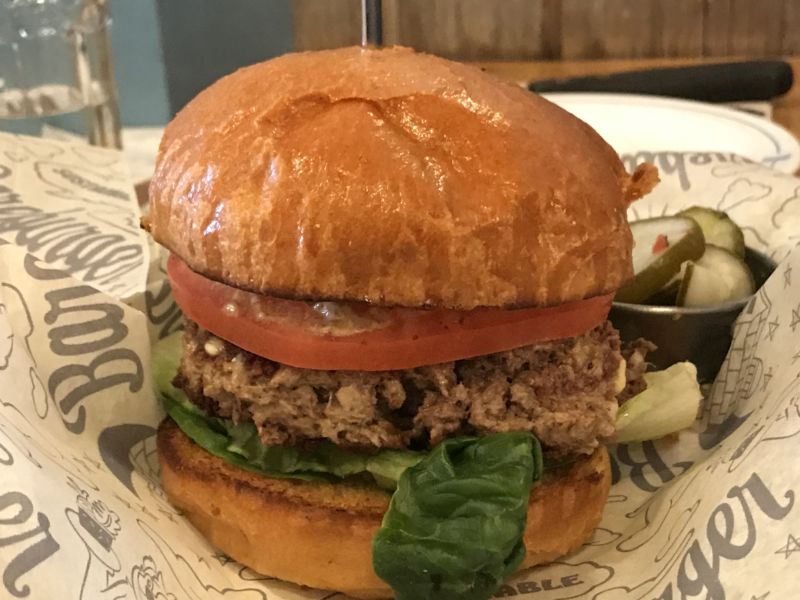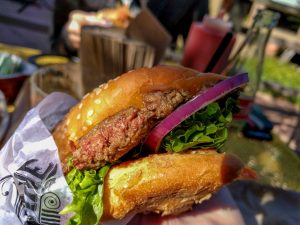
A beefy burger without the beef? That is the seemingly impossible promise of the Impossible Burger, a trendy plant-based burger that claims to “bleed,” sear, and taste like the best of the best all-American whoppers—without the environmental impacts of beef production and ethical concerns of meat-eating.
On a cold and dreary Friday, a band of Ars reporters set out to nosh these mythical sandwich beasts for ourselves to see if the impossible had indeed been accomplished.
Before this, all indications were that it had. Since its introduction in 2016, the Impossible Burger has graced the menus of high-end restaurants such as Momofuku Nishi in New York and Jardinière in San Francisco. Investors have forked over more than $250 million to the faux meat’s maker, Impossible Foods. Impossible Burgers are now served in dozens of restaurants across the country. And the company has “ambitious plans to open new production facilities and partner with a ton more restaurants across the United States,” according to its website.
The faux burger’s star power comes from the addition of leghemoglobin, a protein extracted from the roots of soybean plants. The iron-containing molecule is similar to hemoglobin, an oxygen-carrying protein in red blood cells. “It’s what makes the Impossible Burger so rich and decadent,” according to Impossible Foods. It also helps create the reddish, meat-like juices that “bleed” like those from real burgers.Though Impossible Foods has used this ingredient as a selling point, it’s also brought the company controversy. Last year, documents obtained by a Freedom of Information Act request revealed that the Food and Drug Administration had questioned the safety and testing of leghemoglobin in the meatless meat. Impossible Foods reports that it has submitted additional data to appease the agency. But, due to a controversial interpretation of laws, Impossible Foods is allowed to keep selling its burgers without first convincing the FDA.
The taste test
So here we are. Is this faux, bloody, controversial burger garnering culinary accolades and millions in investment dollars really as good as it seems?
A group of us—Ars IT Editor Sean Gallagher, his wife Paula, Automotive Editor Jonathan Gitlin, Senior Tech Policy Reporter Timothy Lee, and me—met for lunch at a burger joint called Bareburger in DC’s Dupont Circle to find out. To cut to the chase, the results were mixed.
We each ordered our own burger, trying to stick with the toppings, meat doneness, and other fixings that we’d get on a regular burger outing. We also ordered a second meatless-burger option, a Beyond Burger, for comparison. Up front: I mostly eat vegetarian (I will occasionally eat some seafood) and haven’t eaten a burger in years. Everyone else eats meat.
When the burgers arrived, the first thing we all noticed was the thickness and lumpy nature of them. Impossible Burgers are actually sold like ground beef, so patty form and thickness depends on the restaurant. Ours were very fat and irregular—not the smooth, pressed patties you’d see from pre-made burgers.
- The burgers arrive.
- Tim got one with mushrooms.
- The Impossible Burger IRL.
- The medium-done burger was not juicy.
- The first bite. It was not impressive.
- They all had this kind of crumbly texture.
- Everyone agreed their Impossible Burgers were too dry.
- Some showed some signs of pink in the middle.
Taking a bite, we all noted and agreed that the outside of the burgers were crisp and seared, similar to a real burger that had sizzled on a grill. Inside, we generally thought that the mouthfeel of the meat was OK—not great—and on the dry side. Sean ordered his medium-rare, while the rest of us went medium. He noted more pink on the inside than the rest of us did with our burgers, but he still felt the burger was dry. Overall, the texture seemed more crumbly and looser than actual meat or a standard veggie burger.
Taste-wise, we disagreed. Tim had the most favorable opinion. “Overall, I liked the Impossible Burger,” he noted afterward. “It’s not the best burger I’ve ever had, but it’s a convincing imitation. If I got one and didn’t know it was an Impossible Burger, I don’t think I would have noticed the difference.”
The outer crispiness and the smell won him over, though he noted the suboptimal texture and dryness.
“If you’re looking for the juiciest, most flavorful hamburger around, this isn’t it," he said. "But if you’re someone who would like to eat less meat—for moral, dietary, or environmental reasons—but can’t bear the though of giving up beef, the Impossible Burger is a compelling product.”
Jonathan, on the other hand, was probably the harshest critic. “The crust on the Impossible burger was pretty good, and maybe if the patty was thinner it would have worked better. But I wasn’t a fan of the taste, which was a little bitter and lingered at least until I got to the metro station,” he said. Overall, he rated the Impossible Burger a three on a scale of 10, with 10 being the best.
Sean and Paula had a similar take, both saying they didn’t dislike it but wouldn’t go out of their way to eat one again. Sean noted that it has the aesthetics of a burger but doesn’t match up with the taste and tended to fall apart while you were eating it, unlike real meat. Paula said she got a weird and unpleasant nutty flavor that seemed to linger from the meat (I, too, noticed this.)
For me, overall, the Impossible Burger wasn’t great. As someone who doesn’t really remember what hamburgers taste like, I was mostly comparing them to other veggie burgers I’ve had. After this taste test, I would take an old-school Boca burger over an Impossible Burger any day. I definitely felt like there was a meaty flavor, reminiscent of ground chuck that regular veggie burgers lack. But the dryness, odd texture, and dull flavor didn’t do anything for me. If I had to imagine what a crappy, low-quality beef burger tastes like, it would be this.
Beyond impossible
For the Beyond Burger, we were in agreement that it was much more artificial and more similar to conventional veggie burgers than the Impossible Burger.
- The Beyond burger was much more veggie burger-like.
- We got ours with some standard toppings
- The faux meats side-by-side, with Beyond on the left and Impossible on the right.
“I was not as impressed with the Beyond Burger,” Tim said. “It looks and tastes more like meat than conventional veggie burgers, but it's also fairly obvious that it’s not hamburger.”
It was a turnoff to everyone else, but for me, this was a selling point. I’d probably order a Beyond Burger again, and I’d definitely order one over an Impossible Burger. We all agreed that the texture was more like sausage than a hamburger and it had more artificial, non-meat-imitating flavors.
Though we ended our meal disappointed, we’re left wondering if it was all the Impossible Burger’s fault. Our colleague Scott Johnson reported a completely opposite experience when he tried one for the first time a few weeks ago at Dellepiane in Sedona, Arizona.
“I think it just about met the hyped expectations I went in with,” he said, noting that he’s also a vegetarian and he had no interest in looking for a perfect meat replica.

Ars' Sam Machkovech, a meat eater, also reported liking the burger, which he had last month at the Hopdoddy burger chain in Austin, Texas. He ordered his Impossible patty medium-rare as part of a salad. "By itself, the patty was a little bland," Sam said. "But every time I put together a bite with sauce, cheese, veggies, and peppers, I was satisfied. It carried the other ingredient flavors while keeping the juicy, chewy mouth feel I like in a bloody beef burger."
The thing that struck some of us about these reviews was that they said the burger was very juicy, while ours were rather dry. Perhaps when prepared differently or cooked for less time, the Impossible Burger could be impossibly good. But, from DC, the impossible task now may be getting some of us to try them again.
https://arstechnica.com/gaming/2018/02/is-the-impossible-burger-the-meatless-future-of-meat-were-not-so-sure/Bagikan Berita Ini














0 Response to "The meatless Impossible Burger bleeds and sears, but wasn't a crowd pleaser"
Post a Comment